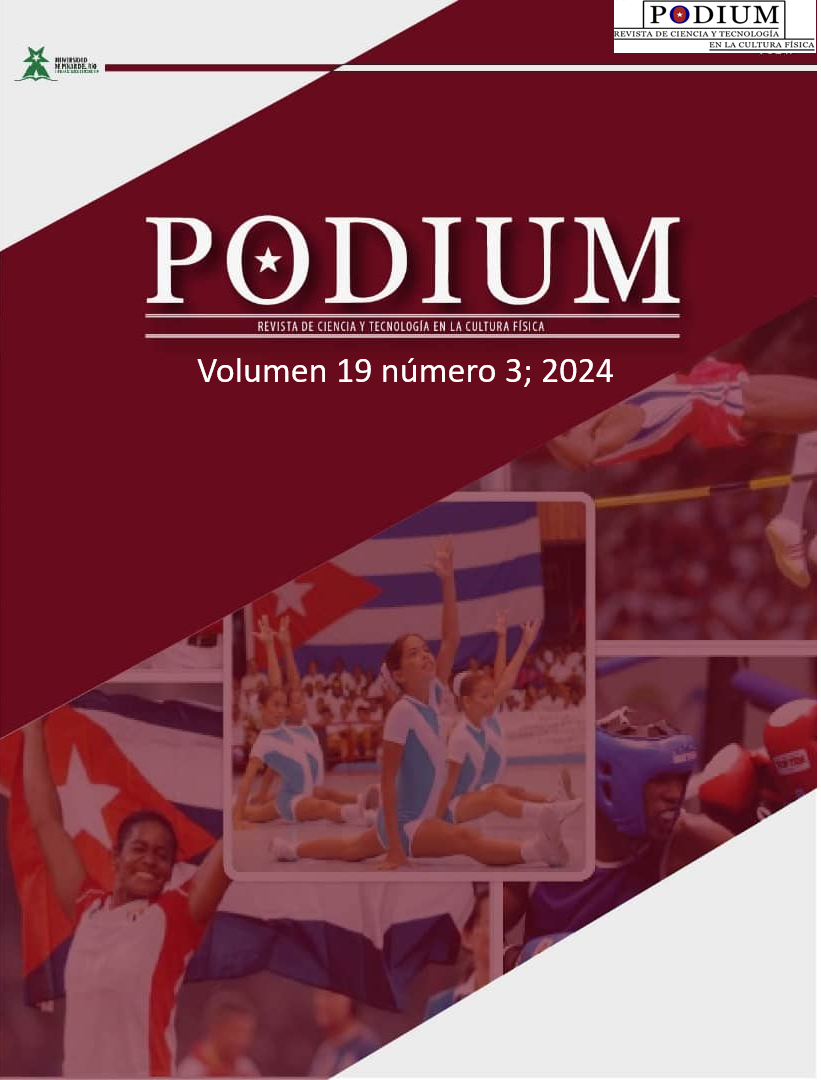Capacidade de salto em atletas de ginástica artística e rítmica
##plugins.themes.bootstrap3.article.main##
Resumo
A Federação Internacional de Ginástica reconhece 6 modalidades esportivas, que possuem características próprias que permitem diferenciá-las entre si. Para esta pesquisa, determinou-se estudar duas delas, a Ginástica Artística e a Ginástica Rítmica, especificamente em atletas do sexo feminino. Isso porque a ginástica rítmica é uma disciplina exclusiva das mulheres, enquanto a ginástica artística é praticada por mulheres e homens; Portanto, é mais que prudente desenvolver pesquisas sobre essas considerações, baseadas em argumentos anatômicos e fisiológicos, que, somadas às demandas de ambas as disciplinas da ginástica e da acrobacia, permitem uma maior compreensão das variáveis a serem investigadas. Assim, o objetivo desta pesquisa é realizar uma análise da capacidade de salto em atletas de Ginástica Rítmica e Artística; por meio da revisão sistemática de teses, periódicos digitais e artigos acadêmicos. Seguindo as diretrizes do método PRISMA. Onde os resultados indicam que a capacidade de salto difere significativamente no que diz respeito ao seu desenvolvimento nestas duas disciplinas. Sendo na ginástica artística mais relevante pela natureza dos aparelhos e exigências no seu desenvolvimento; que, na ginástica rítmica, onde apesar de compartilharem requisitos artísticos semelhantes, não os compartilham na acrobacia, portanto não exige o mesmo nível de desenvolvimento.
Downloads
##plugins.themes.bootstrap3.article.details##

Este trabalho encontra-se publicado com a Creative Commons Atribuição-NãoComercial 4.0.
Referências
Agostini, B., Godoy, E., Almeida, R., Macedo, F., y Alves, N. (2017). Analysis of the influence of plyometric training in improving the performance of athletes in rhythmic gymnastics. Motricidade, 13(2), 71-80. http://dx.doi.org/10.6063/motricidade.9770
Allen, H. (2023). Las diferencias entre gimnasia artística masculina y femenina. Sankris Gymnastics Art Studio. https://www.sankrisgymnastics.com/blog/las-diferencias-entre-gimnasia-artistica-masculina -y-femenina/
Bogdanis, G., Donti, O., Papia, A., Donti, A., Apostolidis, N., & Sands, W. (2019). Effect of Plyometric Training on Jumping, Sprinting and Change of Direction Speed in Child Female Athletes. Sports, 7(5), 116-126. https://doi.org/10.3390%2Fsports7050116
Cabrejas, C., Solana, M., Morales, J., Nieto, A., Bofill, A., Carballeira, E., & Pierantozzi, Em. (2023). The Effects of an Eight-Week Integrated Functional Core and Plyometric Training Program on Young Rhythmic Gymnasts' Explosive Strength. International Journal of Environmental Research and Public Health, 20(2), 1041-1061. https://doi.org/10.3390/ijerph20021041
Chiriac, T., Teodorescu, S. Bota, A. & Mezei, M. (2021). The duration of technical elements in rhythmic gymnastics jumps - a longitudinal and correlational study. Physical Education, Sport and Kinetotherapy Journal, 60(3), 265-279. https://doi.org/10.35189/dpeskj.2021.60.3.6
Deliceoglu, G., Atalay, G., & Kabak, B. (2024). The effect of leg stiffness on reactive agility, jumping and speed in gymnastics athletes. Science of Gymnastics Journal, 16(1), 55-65. http://dx.doi.org/10.52165/sgj.16.1.55-65
Díaz, D., Robert, R. & Asin, M. (2019). Referentes teóricos del desarrollo de la saltabilidad en la categoría 8 años de Gimnasia Artística. ROCA. Revista científico-educacional de la provincia Granma 15(3), 191-202. https://dialnet.unirioja.es/servlet/articulo?codigo=7121643
Federación Internacional de Gimnasia FIG. (2022). Gimnasia Rítmica. FIG: https://www.gymnastics.sport/site/discipline.php?disc=4
Ferreira, L., Leite, I., Batista, A., & Tristão, M. (2023). Jump ability and force-velocity profile in rhythmic gymnastics. Science of Gymnastics Journal, 15(2), 225-237. https://doi.org/10.52165/sgj.15.2.225-237
Gómez, L., Vernetta, M., & López, J. (2011). Análisis comparativo de la capacidad de salto en gimnastas de trampolín españoles. Revista Internacional de Ciencias del Deporte, 7(24), 191-202. https://www.redalyc.org/articulo.oa?id=71018866004
Leite, I., Goethel,. M. Cenceicao, F., & Ávila, L. (2023). How Does the Jumping Performance Differs between Acrobatic and Rhythmic Gymnasts? Biomechanics, 3(4), 457-468. https://doi.org/10.3390/biomechanics3040037
Leyton, M., del Campo, V., Solana, R., & Morenas, J. (2012). Perfil y diferencias antropométricas y físicas de gimnastas de tecnificación de las modalidades de artística y rítmica. RETOS. Nuevas Tendencias en Educación 21, 5862. https://doi.org/10.47197/retos.v0i21.34606
Marinšek, M., & Samardžija, M. (2020). Association between muscles' contractile properties and jumping performance in gymnasts. Science of Gymnastics Journal, 12(1), 75-86. http://dx.doi.org/10.52165/sgj.12.1.75-86
Moreno, Begoña, Muñoz, Maximiliano, Cuellar, Javier, Domancic, Stefan, & Villanueva, Julio. (2018). Revisiones Sistemáticas: definición y nociones básicas. Revista clínica de periodoncia, implantología y rehabilitación oral, 11(3), 184-186. http://dx.doi.org/10.4067/S0719-01072018000300184
Muñoz, D. (2018). Fundamentos teóricos, pedagógicos y didácticos de los deportes acrobáticos. Bogotá: Ediciones USTA, Universidad Santo Tomás. https://repository.usta.edu.co/bitstream/handle/11634 /10593/Mo%CC%81dulo%20Deportes%20acroba%CC%81ticos.pdf
Papia, A., Apostolidis, N., Bogdanis, G., & Donti, O. (2018). Jumping performance is not a strong predictor of change of direction and sprinting ability in preadolescent female gymnasts. Science of Gymnastics, 10(2), 273-283. https://www.proquest.com/openview/8a0e374d5cf1fd69493698e0058f073d/1?pq -origsite=gscholar&cbl=666318
Pérez, J., Rodríguez, G., Royo, I., Arteaga, R., Calbet, J., & Dorado, C. (2006). Capacidad de salto en niñas prepúberes que practican gimnasia rítmica. Motricidad. European Journal of Human Movement. 15(4), 186-192. https://dialnet.unirioja.es/descarga/articulo/2279575.pdf
Rodríguez, L., Guerra, M., y Lores, L. (2018). Influencia de los ejercicios básicos en las habilidades técnicas de las niñas de la gimnasia rítmica. Olimpia: Revista de la Facultad de Cultura Física de la Universidad de Granma, 15(48), 79-90. https://dialnet.unirioja.es/servlet/articulo?codigo=6399857
Ruano, C., & Cejuela-Anta, R. (2020). Evaluación de los principales factores de rendimiento en gimnasia rítmica. Comparación entre diferentes niveles. Cultura, Ciencia y Deporte, 15(44), 65-175. https://doi.org/10.12800/ccd.v15i44.1459
Russo, L., Palermi, S., Dhahbi, W., Delas, S., Bragazzi, N., & Padulo, J. (2020). Selected components of physical ftness in rhythmic and artistic youth gymnast. Sport Sciences for Health, 17, 415-421. https://doi.org/10.1007/s11332-020-00713-8
Sanchez, P. & Hernandez, J. (2021). Efecto de diferentes tipos de entrenamiento físico en la altura de salto de gimnastas: meta-análisis. Pensar en Movimiento, revista de ciencias del ejercicio y la salud, 19(1), 1-35. https://doi.org/10.15517/pensarmov.v19i1.43155
Schärer, C., Reinhart, L., & Hübner, K. (2023). Age-Related Differences between Maximum Flight Height of Basic Skills on Floor, Beam and Vault and Physical Condition of Youth Female Artistic Gymnasts. Sports 2023, 11, 100. https://doi.org/10.3390/sports11050100
Sáez, E., Alarcón, M., Valdés, P., & Guzmán, E. (2023). Efectos de seis semanas de entrenamiento isoinercial sobre la capacidad de salto, velocidad de carrera y equilibrio postural dinámico. Retos, 48, 291297. https://doi.org/10.47197/retos.v48.95284
Skopal, L., Netto, K., Aisbett, B., Takla, Amir., & Castricum, T. (2020). The effect of a rhythmic gymnastics-based power-flexibility program on the lower limb flexibility and power of contemporary dancers. The International Journal of Sports Physical Therapy, 15(3), 343-364. http://dx.doi.org/10.26603/ijspt20200343
Soenyoto, T., Aji, Ranu., Darmawan, A., & Irsyada, R. (2021). Contribution of Leg Flexibility, Limb Length, Leg Power for the Split Leap Skills of Rhythmic Gymnastics Athletes. International Journal of Human Movement and Sports Sciences 9(4), 648-653. http://dx.doi.org/10.13189/saj.2021.090407


